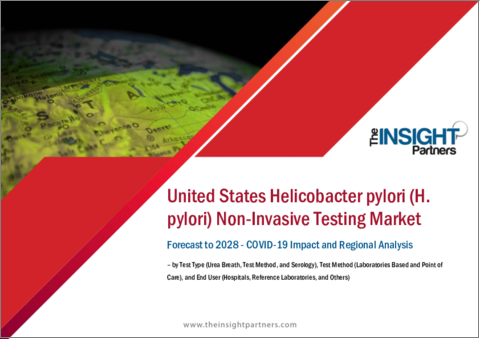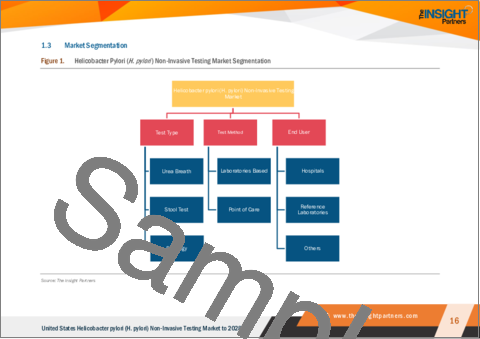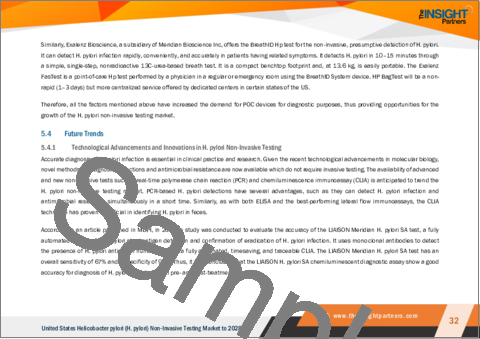|
|
市場調査レポート
商品コード
1296776
米国のヘリコバクター・ピロリ非侵襲的検査市場の2028年までの予測- 検査タイプ別、検査方法別、エンドユーザー別の国別分析US Helicobacter Pylori Non-Invasive Testing Market Forecast to 2028 - Country Analysis By Test Type, Test Method, and End User |
||||||
|
|||||||
| 米国のヘリコバクター・ピロリ非侵襲的検査市場の2028年までの予測- 検査タイプ別、検査方法別、エンドユーザー別の国別分析 |
|
出版日: 2023年06月01日
発行: The Insight Partners
ページ情報: 英文 112 Pages
納期: 即納可能
|
- 全表示
- 概要
- 図表
- 目次
米国のヘリコバクター・ピロリ非侵襲的検査市場規模は、2022年の2億2,376万米ドルから2028年には3億279万米ドルに成長すると予測され、2023年から2028年までのCAGRは5.3%を記録すると推定されます。米国のヘリコバクター・ピロリ非侵襲的検査市場の成長は、ピロリ菌感染の有病率の増加とピロリ菌非侵襲的検査の市場開拓活動の高まりに起因しています。しかし、ピロリ菌の無症状性が米国のヘリコバクター・ピロリ非侵襲的検査市場の成長を妨げています。
ピロリ菌は胃感染、消化性潰瘍、胃炎を引き起こす細菌です。細菌感染が長期化すると、場合によっては胃がんになることもあります。ピロリ菌感染は米国のヒスパニック系および黒人集団でより一般的であり、これは低所得や識字率、世帯の混雑、大規模な移民などの社会経済的要因に起因しています。したがって、ピロリ菌感染の有病率の増加は、米国のヘリコバクター・ピロリ非侵襲的検査市場の燃料となります。
ピロリ菌感染は通常、胃炎、消化性潰瘍疾患、胃がんなどの長年の臨床症状を持つ小児に起こる。Nature Journal誌に掲載された論文によると、ピロリ菌は米国人口の~36%に存在し、胃がんや消化性潰瘍疾患の重大なリスクとなっています。世界保健機関(WHO)はピロリ菌を胃がんにつながる発がん物質として認めており、米国では胃がんは消化器がんの中で3番目に多いです。米国がん協会によると、2023年にはこのがんが原因で26,500人近くが新たに胃がんに罹患し、11,130人が死亡します。このように、がん患者の増加は、米国のヘリコバクター・ピロリ非侵襲的検査市場の成長を増加させています。
さらに、胃疾患に罹患しやすい老人人口の増加は、ピロリ菌感染のリスクを大幅に増加させる。加齢により胃の粘膜が薄くなるため、細菌が保護膜を通過しやすくなり、高齢者の疾患有病率が増加します。老年人口が増加の一途をたどっていることから、ワシントン・ポスト紙は、2040年までに米国の老年人口は8,080万人近くになると推定しています。したがって、老年人口の増加は米国のヘリコバクター・ピロリ非侵襲的検査市場の成長を後押しします。
米国国立衛生研究所の報告によると、2020年の米国における10歳未満の小児のピロリ菌有病率は5%です。また、米国保健福祉省の報告によると、米国人の30~40%がピロリ菌に感染しています。さらに、低所得、教育不足、世帯の混雑、移民などの社会経済的要因が、米国のヒスパニック系および黒人集団におけるピロリ菌感染の一因となっています。これらの統計は、米国におけるピロリ菌の非侵襲的診断のニーズの増加を決定づけ、米国のヘリコバクター・ピロリ菌の非侵襲的検査市場の成長を後押ししています。
検査タイプ別の洞察
検査タイプに基づき、米国のヘリコバクター・ピロリ非侵襲的検査市場は、尿素呼気、便抗原、血清に分類されます。2022年には、尿素呼気セグメントが米国ヘリコバクター・ピロリ非侵襲的検査市場で最大のシェアを占めました。さらに、同セグメントは今後数年間、最も速い速度で成長すると予想されています。尿素呼気試験(UBT)は、ピロリ菌感染を検出するために不可欠な非侵襲的方法の1つです。この検査では、経口投与された尿素を二酸化炭素とアンモニアに加水分解するウレアーゼ酵素を産生する能力に基づいてピロリ菌を検出します。これらのガスは血液中に拡散し、肺から排泄されます。UBTは、成人および小児で有効な、信頼性が高く負担の少ない検査です。したがって、これらは米国のヘリコバクター・ピロリ非侵襲的検査市場規模の成長に寄与しています。
Cancer Research UKによると、慢性的な細菌感染は、重症慢性萎縮性胃炎(SCAG)としても知られる長期にわたる胃の炎症を引き起こします。世界保健機関(WHO)によると、がんは世界中で重要な死因であり、2021年には世界で約190万人の新たながん患者が記録されました。大腸がんは一般的なタイプで、2022年には146,589人の新規症例が記録されました。このタイプのがんは、中年および老年人口に多くみられます。遺伝的素因や素因のある40歳未満の人に発生することは稀です。大腸がんの予防には、適切な検査によるピロリ菌の早期発見が必要です。早期診断は、がんに関連する死亡率を減少させるために極めて重要です。したがって、細菌感染症例の増加により尿素呼気試験が必要となり、米国のヘリコバクター・ピロリ非侵襲的検査市場の成長に寄与しています。
2020年2月、Gulf Coast Scientific社は、ピロリ菌感染検出用の13C UBTであるPylo Plus UBT Systemの米国食品医薬品局(FDA)からの承認を取得しました。さらに、米国のヘリコバクター・ピロリ非侵襲的検査市場の主要企業は、新製品を投入してプレゼンスを拡大するために提携を結ぶ。例えば、2021年にMeridian Bio社は大塚製薬からBreahTrek社を2,000万米ドルで買収する契約を締結しました。このような提携は、UBTセグメントにおける新製品の上市につながり、予測期間中の米国ヘリコバクター・ピロリ非侵襲的検査市場全体の成長に寄与します。
目次
第1章 イントロダクション
第2章 米国ヘリコバクター・ピロリ(H.ピロリ)非侵襲的検査市場の要点
第3章 調査手法
- 調査範囲
- 2次調査
- 1次調査
第4章 米国ヘリコバクター・ピロリ(H.ピロリ)非侵襲的検査-市場情勢
- PEST分析
- 米国のPEST分析
- 専門家の見解
- 米国のヘリコバクター・ピロリ(H.ピロリ)非侵襲的検査市場:数量、検査タイプ別、2022年
第5章 ヘリコバクター・ピロリ(H.ピロリ)非侵襲的検査市場:主要産業力学
- 主な市場促進要因
- ピロリ菌感染の有病率の増加
- ピロリ菌非侵襲的検査における市場開拓活動の活発化
- 主な市場抑制要因
- ピロリ菌の無症状性
- 主な市場機会
- 在宅POC機器の使用の増加
- 今後の動向
- ピロリ菌非侵襲的検査における技術の進歩と革新
- 影響分析
第6章 米国ヘリコバクター・ピロリ(H.ピロリ)非侵襲的検査の市場分析
- 米国ヘリコバクター・ピロリ(H.ピロリ)非侵襲的検査市場の収益と予測分析
- 主要プレイヤーの市場ポジショニング
第7章 米国ヘリコバクター・ピロリ(H.ピロリ)非侵襲的検査市場分析:検査タイプ別
- 尿素呼気
- 便抗原
- 血清検査
第8章 米国ヘリコバクター・ピロリ(H.ピロリ)非侵襲的検査市場分析:検査方法別
- 検査室ベース
- ポイント・オブ・ケア
第9章 米国ヘリコバクター・ピロリ(H.ピロリ)非侵襲的検査市場分析:エンドユーザー別
- 病院
- リファレンスラボ
- その他
第10章 米国ヘリコバクター・ピロリ(H.ピロリ)非侵襲的検査市場
- 米国
第11章 米国ヘリコバクター・ピロリ(H.ピロリ)非侵襲的検査市場:業界情勢
- ヘリコバクター・ピロリ(H.ピロリ)非侵襲的検査市場における成長戦略
- 無機的成長戦略
- 有機的成長戦略
第12章 企業プロファイル
- Bioneer Corp
- Meridian Bioscience Inc
- Abbott Laboratories
- Thermo Fisher Scientific Inc
- Bio-Rad Laboratories Inc
- Coris BioConcept SPRL
- DiaSorin SpA
- Sekisui Diagnostics LLC
- CerTest Biotec SL
- QuidelOrtho Corporation
第13章 付録
List Of Tables
- Table 1. United States Helicobacter pylori (H. pylori) Non-Invasive Testing Market, by Test Type - Volume 2022 (Million)
- Table 2. United States Helicobacter pylori (H. pylori) Non-Invasive Testing Market, by Test Type - Revenue and Forecast to 2028 (US$ Million)
- Table 3. United States Helicobacter pylori (H. pylori) Non-Invasive Testing Market, by Test Method - Revenue and Forecast to 2028 (US$ Million)
- Table 4. United States Helicobacter pylori (H. pylori) Non-Invasive Testing Market, by End User - Revenue and Forecast to 2028 (US$ Million)
- Table 5. Recent Inorganic Growth Strategies in the H. pylori Non-Invasive Testing Market
- Table 6. Recent Organic Growth Strategies in the H. pylori Non-Invasive Testing Market
- Table 7. Glossary of Terms
List Of Figures
- Figure 1. Helicobacter Pylori (H. pylori ) Non-Invasive Testing Market Segmentation
- Figure 2. US Helicobacter pylori (H. pylori) Non-invasive Testing Market Overview
- Figure 3. Urea Breath Segment Held Largest Share of Test Type Segment in Helicobacter pylori (H. pylori) Non-invasive Testing Market
- Figure 4. US Helicobacter pylori (H. pylori) Non-invasive Testing Market, Industry Landscape
- Figure 5. US: PEST Analysis
- Figure 6. Experts Opinion
- Figure 7. Helicobacter pylori Non-Invasive Testing Market Impact Analysis of Driver and Restraints
- Figure 8. US Helicobacter pylori (H. pylori) Non-invasive Testing Market- Revenue Forecast and Analysis - 2020 - 2028
- Figure 9. Market Positioning of Key Players in US Helicobacter pylori (H. pylori) Non-Invasive Testing Market
- Figure 10. United States Helicobacter pylori (H. pylori) Non-Invasive Testing Market, by Type, 2022 & 2028 (%)
- Figure 11. Urea Breath: United States Helicobacter pylori (H. pylori) Non-Invasive Testing Market - Revenue and Forecast to 2028 (US$ Million)
- Figure 12. Stool Antigen: United States Helicobacter pylori (H. pylori) Non-Invasive Testing Market - Revenue and Forecast to 2028 (US$ Million)
- Figure 13. Serology: United States Helicobacter pylori (H. pylori) Non-Invasive Testing Market - Revenue and Forecast to 2028 (US$ Million)
- Figure 14. United States Helicobacter pylori (H. pylori) Non-Invasive Testing Market, by Test Method, 2022 & 2028 (%)
- Figure 15. Laboratory Based: Helicobacter pylori (H. pylori) Non-Invasive Testing Market- Revenue and Forecast to 2028 (US$ Million)
- Figure 16. Point of Care: Helicobacter pylori (H. pylori) Non-Invasive Testing Market- Revenue and Forecast to 2028 (US$ Million)
- Figure 17. United States Helicobacter pylori (H. pylori) Non-Invasive Testing Market, by End User, 2022 & 2028 (%)
- Figure 18. Hospitals: United States Helicobacter pylori (H. pylori) Non-Invasive Testing Market - Revenue and Forecast to 2028 (US$ Million)
- Figure 19. Specialty Clinics: United States Helicobacter pylori (H. pylori) Non-Invasive Testing Market - Revenue and Forecast to 2028 (US$ Million)
- Figure 20. Others: United States Helicobacter pylori (H. pylori) Non-Invasive Testing Market - Revenue and Forecast to 2028 (US$ Million)
- Figure 21. Impact of COVID-19 Pandemic on US Helicobacter pylori (H. pylori) Non-Invasive Testing Market
- Figure 22. Growth Strategies in the Helicobacter pylori Non-Invasive Testing Market
The US Helicobacter Pylori Non-Invasive Testing Market size is expected to grow from US$ 223.76 million in 2022 to US$ 302.79 million by 2028; it is estimated to record a CAGR of 5.3% from 2023 to 2028. The US Helicobacter Pylori non-invasive testing market growth is attributed to the increasing prevalence of H. pylori bacterial infection and rising market development activities in H. pylori non-invasive test. However, asymptomatic nature of H. pylori is hampering the growth of the US Helicobacter Pylori Non-Invasive Testing market.
H. pylori is a bacterium causing stomach infection, peptic ulcer, and gastritis. The prolonged bacterial infection may lead to stomach cancer in some cases. The H. pylori infection is more common in the US Hispanic and black populations, which can be credited to socioeconomic factors such as low income and literacy, household crowding, and large-scale immigration. Thus, increase in prevalence of H. pylori infection fuel the US Helicobacter pylori non-invasive testing market.
The H. pylori infection usually occurs in children with long-standing clinical symptoms such as gastritis, peptic ulcer disease, and stomach cancer. According to an article published in the Nature Journal, H. pylori is present in ~36% of the US population, posing a significant risk for gastric cancer and peptic ulcer disease. The World Health Organization (WHO) has recognized H. pylori as a carcinogen that leads to gastric cancer and in the US, gastric cancer is the third most common gastrointestinal cancer. According to the American Cancer Society, nearly 26,500 new cases of stomach cancer and ~11,130 deaths will occur due to this cancer type in 2023. Thus, growing cancer cases increases the US Helicobacter pylori non-invasive testing market growth.
Further, the growing geriatric population pool susceptible to gastric diseases will substantially increase the risk of H. pylori infection. Aging leads to thinning of the stomach lining, thus allowing the bacteria to pass through the protective lining, thereby increasing the disease prevalence among older people. Given the constant increase in the geriatric population base, the Washington Post has estimated that there will be nearly 80.8 million senior citizens in the US by 2040. Thus, growing geriatric population boosts the growth of US Helicobacter pylori non-invasive testing market.
According to a report from the National Institutes of Health, there was a 5% prevalence of H. pylori in children under the age of 10 in the US in 2020. In addition, the US Department of Health and Human Services reports that 30-40% of Americans are infected with H. pylori infection. Further, socioeconomic factors, such as low income, lack of education, household crowding, and immigration contribute to H. pylori infection among Hispanic and Black populations in the US. These statistics determine an increase in the need for non-invasive diagnostics for H. pylori in the US, thus, boosting the growth of the US Helicobacter pylori non-invasive testing market.
Test Type Insights
Based on test type, the US Helicobacter pylori non-invasive testing market is categorized into urea breath, stool antigen, and serology. In 2022, the urea breath segment held the largest share of the US Helicobacter pylori non-invasive testing market. Moreover, the same segment is expected to grow at the fastest rate during the coming years. A urea breath test (UBT) is one of the essential noninvasive methods for detecting H. pylori infection. The test involves detecting H. pylori based on its ability to produce urease enzyme, which results in the hydrolysis of orally administered urea into carbon dioxide and ammonia. These gases diffuse into the blood, and the lungs then excrete them. UBTs are reliable, low-burden tests validated in adults and children. Thus, these contribute to the growth of US Helicobacter pylori non-invasive testing market size.
According to Cancer Research UK, chronic bacterial infection causes long-lasting stomach inflammation, also known as severe chronic atrophic gastritis or SCAG; prolonged stomach ulcers can even lead to cancer. According to the World Health Organization (WHO), cancer is a significant cause of death across the world; approximately 1.9 million new cancer cases were recorded in the world in 2021. Colorectal cancer is a common type, with 146,589 new cases recorded in 2022. This type of cancer is more prevalent in middle-aged and geriatric populations. It rarely occurs among people aged less than 40 with genetic predisposition or predisposing conditions. The early detection of H. pylori via appropriate tests is necessary to prevent colorectal cancer. Early diagnosis is pivotal to reducing cancer-related mortality rates. Thus, the rising cases of bacterial infections are necessitating urea breath tests which contributes to the growth of US Helicobacter Pylori non-invasive testing market.
In February 2020, Gulf Coast Scientific received approval from the US Food and Drug Administration (FDA) for the Pylo Plus UBT System, a 13C UBT for the detection of H. pylori infection. In addition, key players in the US Helicobacter pylori non-invasive testing market form alliances to introduce new products and expand their presence. For instance, in 2021, Meridian Bio signed an agreement to acquire BreahTrek from Otsuka Pharmaceutical for US$ 20 million. Such collaborations led to the new product launches in the UBT segment and contribute the overall growth of US Helicobacter pylori non-invasive testing market during the forecast period.
Reasons to Buy:
- Save and reduce time carrying out entry-level research by identifying the growth, size, leading players, and segments in the US H. pylori non-invasive testing market.
- Highlights key business priorities in order to assist companies to realign their business strategies.
- The key findings and recommendations highlight crucial progressive industry trends in the US H. pylori non-invasive testing market, thereby allowing players across the value chain to develop effective long-term strategies.
- Develop/modify business expansion plans by using substantial growth offering developed and emerging markets.
- Scrutinize in-depth global market trends and outlook coupled with the factors driving the market, as well as those hindering it.
- Enhance the decision-making process by understanding the strategies that underpin security interest with respect to client products, segmentation, pricing, and distribution.
Table Of Contents
1. Introduction
- 1.1 Scope of the Study
- 1.2 The Insight Partners Research Report Guidance
- 1.3 Market Segmentation
- 1.3.1 US Helicobacter pylori (H. pylori) Non-Invasive Testing Market - By Test Type
- 1.3.2 US Helicobacter pylori (H. pylori) Non-Invasive Testing Market - By Test Method
- 1.3.3 US Helicobacter pylori (H. pylori) Non-Invasive Testing Market - By End User
2. US Helicobacter pylori (H. pylori) Non-invasive Testing Market Key Takeaways
3. Research Methodology
- 3.1 Coverage
- 3.2 Secondary Research
- 3.3 Primary Research
4. US Helicobacter pylori (H. pylori) Non-invasive Testing Market - Market Landscape
- 4.1 Overview
- 4.2 PEST Analysis
- 4.2.1 US PEST Analysis
- 4.3 Experts Opinion
- 4.4 United States Helicobacter pylori (H. pylori) Non-Invasive Testing Market, by Test Type - Volume 2022 (Million)
5. Helicobacter pylori (H. pylori ) Non-Invasive Testing Market - Key Industry Dynamics
- 5.1 Key Market Drivers
- 5.1.1 Increasing Prevalence of H. pylori Bacterial Infection
- 5.1.2 Rising Market Development Activities in H. pylori Non-Invasive Testing
- 5.2 Key Market Restraints
- 5.2.1 Asymptomatic Nature of H. pylori
- 5.3 Key Market Opportunities
- 5.3.1 Increasing Use of Home-Based Point of Care Devices
- 5.4 Future Trends
- 5.4.1 Technological Advancements and Innovations in H. pylori Non-Invasive Testing
- 5.5 Impact Analysis
6. US Helicobacter pylori (H. pylori) Non-Invasive Testing Market Analysis
- 6.1 US Helicobacter pylori (H. pylori) Non-invasive Testing Market Revenue Forecast and Analysis
- 6.2 Market Positioning of Key Players
7. United States Helicobacter pylori (H. pylori) Non-Invasive Testing Market Analysis - by Test Type
- 7.1 Overview
- 7.2 United States Helicobacter pylori (H. pylori) Non-Invasive Testing Market, by Test Type - Revenue and Forecast to 2028 (US$ Million)
- 7.3 Urea Breath
- 7.3.1 Overview
- 7.3.2 Urea Breath: United States Helicobacter pylori (H. pylori) Non-Invasive Testing Market - Revenue and Forecast to 2028 (US$ Million)
- 7.4 Stool Antigen
- 7.4.1 Overview
- 7.4.2 Stool Antigen: United States Helicobacter pylori (H. pylori) Non-Invasive Testing Market - Revenue and Forecast to 2028 (US$ Million)
- 7.5 Serology
- 7.5.1 Overview
- 7.5.2 Serology: United States Helicobacter pylori (H. pylori) Non-Invasive Testing Market - Revenue and Forecast to 2028 (US$ Million)
8. United States Helicobacter pylori (H. pylori) Non-Invasive Testing Market Analysis - by Test Method
- 8.1 Overview
- 8.2 United States Helicobacter pylori (H. pylori) Non-Invasive Testing Market, by Test Method - Revenue and Forecast to 2028 (US$ Million)
- 8.3 Laboratory Based
- 8.3.1 Overview
- 8.3.2 Laboratory Based: Helicobacter pylori (H. pylori) Non-Invasive Testing Market- Revenue and Forecast to 2028 (US$ Million)
- 8.4 Point of Care
- 8.4.1 Overview
- 8.4.2 Point of Care: Helicobacter pylori (H. pylori) Non-Invasive Testing Market- Revenue and Forecast to 2028 (US$ Million)
9. United States Helicobacter pylori (H. pylori) Non-Invasive Testing Market Analysis - by End User
- 9.1 Overview
- 9.2 United States Helicobacter pylori (H. pylori) Non-Invasive Testing Market, by End User - Revenue and Forecast to 2028 (US$ Million)
- 9.3 Hospitals
- 9.3.1 Overview
- 9.3.2 Hospitals: United States Helicobacter pylori (H. pylori) Non-Invasive Testing Market - Revenue and Forecast to 2028 (US$ Million)
- 9.4 Reference Laboratories
- 9.4.1 Overview
- 9.4.2 Reference Laboratories: United States Helicobacter pylori (H. pylori) Non-Invasive Testing Market - Revenue and Forecast to 2028 (US$ Million)
- 9.5 Others
- 9.5.1 Overview
- 9.5.2 Others: United States Helicobacter pylori (H. pylori) Non-Invasive Testing Market - Revenue and Forecast to 2028 (US$ Million)
10. United States Helicobacter pylori (H. pylori) Non-Invasive Testing Market: Impact Assessment of COVID-19 Pandemic
- 10.1 US: Impact Assessment of COVID-19 Pandemic
11. US Helicobacter pylori (H. pylori) Non-Invasive Testing Market - Industry Landscape
- 11.1 Overview
- 11.2 Growth Strategies in the Helicobacter pylori Non-Invasive Testing Market
- 11.3 Inorganic Growth Strategies
- 11.3.1 Overview
- 11.4 Organic Growth Strategies
- 11.4.1 Overview
12. Company Profiles
- 12.1 Bioneer Corp
- 12.1.1 Key Facts
- 12.1.2 Business Description
- 12.1.3 Products and Services
- 12.1.4 Financial Overview
- 12.1.5 SWOT Analysis
- 12.1.6 Key Developments
- 12.2 Meridian Bioscience Inc
- 12.2.1 Key Facts
- 12.2.2 Business Description
- 12.2.3 Products and Services
- 12.2.4 Financial Overview
- 12.2.5 SWOT Analysis
- 12.2.6 Key Developments
- 12.3 Abbott Laboratories
- 12.3.1 Key Facts
- 12.3.2 Business Description
- 12.3.3 Products and Services
- 12.3.4 Financial Overview
- 12.3.5 SWOT Analysis
- 12.3.6 Key Developments
- 12.4 Thermo Fisher Scientific Inc
- 12.4.1 Key Facts
- 12.4.2 Business Description
- 12.4.3 Products and Services
- 12.4.4 Financial Overview
- 12.4.5 SWOT Analysis
- 12.4.6 Key Developments
- 12.5 Bio-Rad Laboratories Inc
- 12.5.1 Key Facts
- 12.5.2 Business Description
- 12.5.3 Products and Services
- 12.5.4 Financial Overview
- 12.5.5 SWOT Analysis
- 12.5.6 Key Developments
- 12.6 Coris BioConcept SPRL
- 12.6.1 Key Facts
- 12.6.2 Business Description
- 12.6.3 Products and Services
- 12.6.4 Financial Overview
- 12.6.5 SWOT Analysis
- 12.6.6 Key Developments
- 12.7 DiaSorin SpA
- 12.7.1 Key Facts
- 12.7.2 Business Description
- 12.7.3 Products and Services
- 12.7.4 Financial Overview
- 12.7.5 SWOT Analysis
- 12.7.6 Key Developments
- 12.8 Sekisui Diagnostics LLC
- 12.8.1 Key Facts
- 12.8.2 Business Description
- 12.8.3 Products and Services
- 12.8.4 Financial Overview
- 12.8.5 SWOT Analysis
- 12.8.6 Key Developments
- 12.9 CerTest Biotec SL
- 12.9.1 Key Facts
- 12.9.2 Business Description
- 12.9.3 Products and Services
- 12.9.4 Financial Overview
- 12.9.5 SWOT Analysis
- 12.9.6 Key Developments
- 12.10 QuidelOrtho Corporation
- 12.10.1 Key Facts
- 12.10.2 Business Description
- 12.10.3 Products and Services
- 12.10.4 Financial Overview
- 12.10.5 SWOT Analysis
- 12.10.6 Key Developments
13. Appendix
- 13.1 About The Insight Partners
- 13.2 Glossary of Terms





